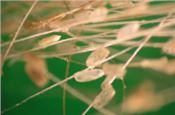|
Cattle Lice
DR. LEE TOWNSEND
LEXINGTON, KY.
Lice may be the reason for cattle scratching to the point of rubbing off large patches of hair or creating raw sores. The biting and sucking lice that infest cattle are most numerous and active during winter and can spread easily from animal by direct contact. Confirm that lice are the reason for the scratching by examining some animals in the herd. Part the animal’s hair in spots where lice are likely to occur and look for lice eggs (nits) attached to hairs (Figure 1).
Biting Lice
The single species of the biting louse that occurs on cattle is about 1/12 inch long with a yellow-white body and wide red head (Figure 2). These lice can be found all over the bodies of young and mature cattle. They feed on skin, skin secretions, and hair, causing irritation.
Sucking Lice
There are three species of sucking lice; they are blood feeders. These lice are most commonly found on the head, neck, brisket, withers, around the base of the tail, and along the inner surfaces of the legs. Shortnose and little blue cattle lice are more often found on older animals; the little blue louse tends to occur on the head. The longnose cattle louse is most often found on young cattle.
Management
If lice are present, two insecticide applications may be needed to clean-up the infestation. The first treatment kills active adult and immature lice but does not kill nits or eggs on the hide. The second application, about 14 days later, targets newly hatched lice.
There are plenty of lice to go around. Different species also attack horses, goats, and swine. The signs and impact on these animals are very similar to what is seen on cattle; the control approach is similar, also. ∆
DR. LEE TOWNSEND: Extension Entomologist, University of Kentucky

Figure 1. Individual nits or eggs of lice are glued to hairs. Look for them when investigating
causes of excessive scratching
Photos courtesy Lee Townsend, UK

Figure 2. Biting lice have wide triangular heads and feet that let them grasp onto hairs.
|
|